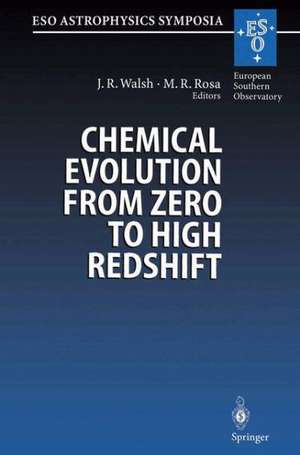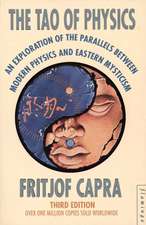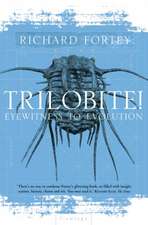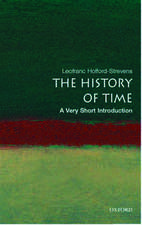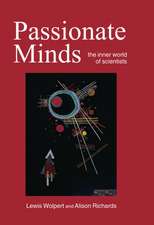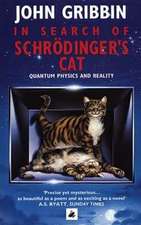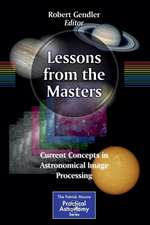Chemical Evolution from Zero to High Redshift: Proceedings of the ESO Workshop Held at Garching, Germany, 14–16 October 1998: ESO Astrophysics Symposia
Editat de Jeremy Walsh, Michael R. Rosaen Limba Engleză Paperback – 18 apr 2014
Din seria ESO Astrophysics Symposia
- 15%
 Preț: 656.43 lei
Preț: 656.43 lei - 15%
 Preț: 656.10 lei
Preț: 656.10 lei -
 Preț: 369.78 lei
Preț: 369.78 lei -
 Preț: 404.51 lei
Preț: 404.51 lei - 15%
 Preț: 644.95 lei
Preț: 644.95 lei - 15%
 Preț: 656.43 lei
Preț: 656.43 lei -
 Preț: 391.97 lei
Preț: 391.97 lei - 18%
 Preț: 971.01 lei
Preț: 971.01 lei -
 Preț: 434.94 lei
Preț: 434.94 lei - 15%
 Preț: 650.86 lei
Preț: 650.86 lei -
 Preț: 402.98 lei
Preț: 402.98 lei -
 Preț: 403.90 lei
Preț: 403.90 lei -
 Preț: 412.78 lei
Preț: 412.78 lei - 15%
 Preț: 645.47 lei
Preț: 645.47 lei -
 Preț: 431.30 lei
Preț: 431.30 lei - 15%
 Preț: 649.06 lei
Preț: 649.06 lei -
 Preț: 402.56 lei
Preț: 402.56 lei - 15%
 Preț: 647.27 lei
Preț: 647.27 lei -
 Preț: 413.15 lei
Preț: 413.15 lei -
 Preț: 409.30 lei
Preț: 409.30 lei -
 Preț: 430.10 lei
Preț: 430.10 lei -
 Preț: 406.42 lei
Preț: 406.42 lei - 15%
 Preț: 658.05 lei
Preț: 658.05 lei - 20%
 Preț: 590.38 lei
Preț: 590.38 lei -
 Preț: 400.65 lei
Preț: 400.65 lei -
 Preț: 413.15 lei
Preț: 413.15 lei - 15%
 Preț: 658.70 lei
Preț: 658.70 lei -
 Preț: 401.79 lei
Preț: 401.79 lei -
 Preț: 436.70 lei
Preț: 436.70 lei -
 Preț: 404.13 lei
Preț: 404.13 lei
Preț: 642.68 lei
Preț vechi: 756.09 lei
-15% Nou
Puncte Express: 964
Preț estimativ în valută:
122.99€ • 127.93$ • 101.54£
122.99€ • 127.93$ • 101.54£
Carte tipărită la comandă
Livrare economică 15-29 aprilie
Preluare comenzi: 021 569.72.76
Specificații
ISBN-13: 9783662216972
ISBN-10: 3662216973
Pagini: 340
Ilustrații: XVIII, 314 p. 122 illus.
Dimensiuni: 155 x 235 x 18 mm
Greutate: 0.48 kg
Ediția:Softcover reprint of the original 1st ed. 1999
Editura: Springer Berlin, Heidelberg
Colecția Springer
Seria ESO Astrophysics Symposia
Locul publicării:Berlin, Heidelberg, Germany
ISBN-10: 3662216973
Pagini: 340
Ilustrații: XVIII, 314 p. 122 illus.
Dimensiuni: 155 x 235 x 18 mm
Greutate: 0.48 kg
Ediția:Softcover reprint of the original 1st ed. 1999
Editura: Springer Berlin, Heidelberg
Colecția Springer
Seria ESO Astrophysics Symposia
Locul publicării:Berlin, Heidelberg, Germany
Public țintă
ResearchCuprins
Chemical Abundances of Local “Unevolved” Stars.- Supernova Nucleosynthesis: Models Versus Observations.- Abundance Gradients from Massive, Early-Type Stars: The Milky Way and Beyond.- Galactic H II Region Abundances.- Nebular Abundances from Recombination Lines.- Abundances in Interstellar Gas.- Constraints on the Nature of Interstellar Dust.- UV Spectral Synthesis for Iron Group Elements in A Supergiants.- Be Abundance in Li-Rich Giants.- The “Abundance Attractor” and the Primordial Lithium Enigma.- Field Blue Stragglers: The Chemical Composition Revisited.- The RGB Bump as a Metallicity Indicator for Globular Clusters.- Observing Boron in Metal-Poor Stars.- Oxygen Abundance in Solar-Type Stars.- Galactic Oxygen Abundance and Gradient from Photometry of H II Regions.- Small-Scale Structure in the Orion Nebula: Evidence for High-Density Condensations.- Chemical Abundances of Planetary Nebulae in the Galaxy and LMC.- Photo-Ionization Modelling of New Planetary Nebulae Within 2° of the Galactic Center.- The s-Process Elements Cadmium and Tin.- Abundance Ratios in Galactic Bulge Stars.- Abundance Gradients in the Galactic Disk: A Clue to Galaxy Formation.- Chemical Evolution of the Magellanic Clouds.- Detection of Extragalactic 15N: Nitrogen Nucleosynthesis and Chemical Evolution.- Chemical Abundances at Large Galactocentric Radii: A Progress Report.- Gas Flows and the Chemical Evolution of Galaxies.- Chemospectral Evolution of the Milky Way and of Spiral Disks.- NLTE Analyses of Magellanic Cloud B Stars.- Alpha-Elements Differential Abundances in M33 B-Supergiants.- Extragalactic Stellar Abundances: Oxygen in Extreme A-Type Supergiants.- Backyard Cosmology: Abundance Observations of Nearby Galaxies.- Empirical Calibrations of Nebular Abundances: The SulphurAbundance Parameter.- Abundances in Spiral and Irregular Galaxies in the Local Universe.- Heavy Element Abundances in the Most Metal Deficient Dwarf Galaxies.- Chemical Evolution of Low Mass Disc Galaxies.- On the Oxygen Abundance Deficiency in Spiral Galaxies.- Spectrophotometric Analysis of HII Regions in the Galaxy NGC 4258.- Diffuse Warm and Hot Gas in I Zw 18.- The Role of Starbursts in the Chemical Evolution of Galaxies.- Metallicity of Dwarf Galaxies in Clusters.- Chemical Evolution and Abundance Ratios in Dwarf Irregular Galaxies.- Constraints on the Chemical Evolution of Nearby Dwarf Galaxies from CMDs.- Elliptical Galaxy Chemical Evolution.- Effects of the Environment on Star Formation and Abundances in Galaxies.- Chemical Evolution on the Scale of Clusters of Galaxies, and Beyond.- Enrichment of the Intracluster Medium.- Stellar Population in a High-Density Environment: Elliptical Galaxies in the Coma Cluster.- The Effects of Cluster Environment on the Chemical Evolution of Galaxies.- The Chemical Composition of Star-Forming Galaxies at High Redshift.- Dust and Molecules at High Redshift.- Molecules in the Shell of Quasars 1556+3517 and 0840+3633.- The N V/C IV Ratio in High-Redshift Radio Galaxies.- Element Abundances at High Redshifts.- Early Metal Formation and the Intergalactic Medium.- Predicting Spectral Properties of DLA Galaxies.- Search for a High-Redshift Damped Lyman-Alpha Absorber with NICMOS.- The Contribution of Galaxies to the Ionising Background Radiation.- Origin of the Continuum in High-Redshift Radio Galaxies.- Element Abundances in Damped Lyman-Alpha Quasar Absorbers.- Interpreting the Redshift Evolution of DLA Galaxies.- The Metal Systems in the Line of Sight Towards GB1759+7539.- The z = 1.6748 C I Absorber Toward the QSO PKS 1756+237.-DLA at Low and Intermediate Redshift.- Present and Forthcoming UV Missions.- Prospects for Chemical Evolution Studies in the Infrared.- Abundance Determinations Through Astrophysical X-Ray Spectroscopy.- Conference Summary.
Textul de pe ultima copertă
The observational and interpretive tools for the study of chemical evolution are starting to be mature enough that they can be applied with some confidence to extra-galactic systems and integrated populations at increasingly high redshift. This book is devoted to the study of the interplay between different methods of measuring chemical abundances with astrophysical models. Studies of chemical abundances and evolution from stars, inter-stellar medium and local group galaxies at zero redshift to distant galaxies, clusters of galaxies and inter-galactic medium at high redshift are presented. There are also synopses on progress in instrumentation for abundance determination.
Caracteristici
This volume is devoted to the study of the spectra of very distant objects that can be observed with the most recent telescopes. Hence, the articles in this book present a lot of material unkown so far to most astronomers.
